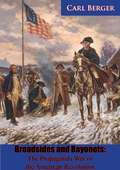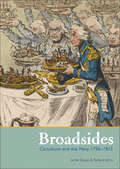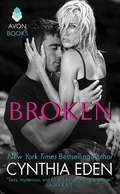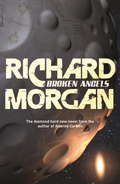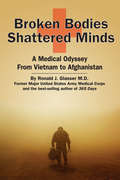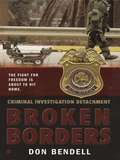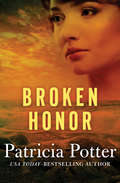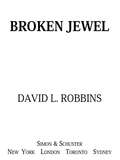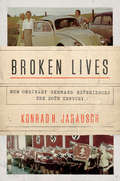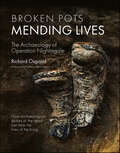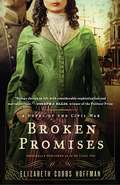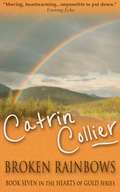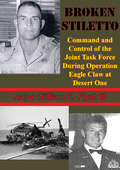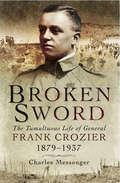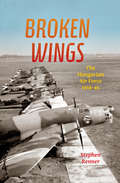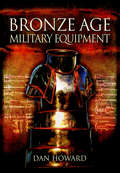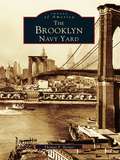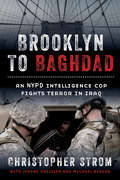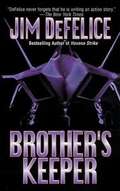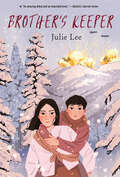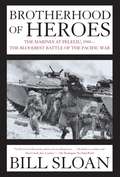- Table View
- List View
Broadsides and Bayonets: The Propaganda War of the American Revolution
by Carl BergerOriginally published in 1961, author Carl Berger has “attempted to encompass the story of propaganda and subversion in the American Revolutionary War. The archives and literature of the Revolution contain many intriguing references to “secret arts and machinations,” some relating to incidents familiar to us, others touching on events long forgotten. This book for the first time brings them together in a single narrative, examining their role and importance.”
Broadsides: Caricatures and the Navy, 1756–1815
by James DaveyBroadsides explores the political and cultural history of the Navy during the later eighteenth and early nineteenth centuries through contemporary caricature. This was a period of intense naval activity encompassing the Seven Years War, the American War of Independence, the wars against revolutionary and Napoleonic France, and the War of 1812.Naval caricatures were utilised by the press to comment on events, simultaneously reminding the British public of the immediacy of war, whilst satirising the same Navy it was meant to be supporting.The thematic narrative explores topics from politics to invasion, whilst encompassing detailed analysis of the context and content of individual prints. It explores pivotal figures within the Navy and the feelings and apprehensions of the people back home and their perception of the former. The text, like the cariactures themselves, balances humour with the more serious nature of the content. The emergence of this popular new form of graphic satire culminated in the works of James Gillray and Thomas Rowlandson, both here well represented, but a mass of other contemporary illustration makes this work a hugely important source book for those with any interest in the wars and history of this era.
Broken
by Cynthia EdenThe first novel in New York Times bestselling author Cynthia Eden's sizzling LOST series introduces the Last Option Search Team, an elite unit that must protect the only surviving victim of a serial killer.Ex-SEAL and LOST founder Gabe Spencer is accustomed to the unusual in his job. But when knockout Eve Gray steps into his office, he's rattled. For the mysterious woman is a dead ringer for the heiress thought to be the latest prey of the serial killer who goes by the name Lady Killer.When Eve awoke in an Atlanta hospital, her past was a blank slate. Then she recognized her own face in the newspaper and vowed to learn the truth. Determined to confront the nightmares hidden in her mind, she never expects to find a partner in Gabe.As Gabe and Eve work together, their explosive attraction becomes irresistible. Gabe knows that his desire for Eve is growing too strong, bordering on a dangerous obsession, but nothing pulls him away from her. And when another Eve lookalike disappears, Gabe vows to protect Eve at all costs. While Eve may have forgotten the killer in her past, it's clear he hasn't forgotten her.
Broken Angels: Netflix Altered Carbon book 2 (Takeshi Kovacs)
by Richard MorganFifty years after the events of ALTERED CARBON, Takeshi Kovacs is serving as a mercenary in the Procterate-sponsored war to put down Joshuah Kemp's revolution on the planet Sanction IV. He is offered the chance to join a covert team chasing a prize whose value is limitless -- and whose dangers are endless. Here is a novel that takes mankind to the brink.A breakneck-paced crime thriller, ALTERED CARBON took its readers deep into the universe Morgan had so compellingly realised without ever letting them escape the onward rush of the plot. BROKEN ANGELS melds SF, the war novel and the spy thriller to take the reader below the surface of this future and lay bare the treacheries, betrayals and follies that leave man so ill-prepared for the legacy he has been given: the stars. This is SF at its dizzying best: superb, yet subtle, world-building; strong yet sensitive characterisation; awesome yet believable technology, thilling yet profound writing. Richard Morgan is set to join the genre's world-wide elite.
Broken Angels: Netflix Altered Carbon book 2 (Takeshi Kovacs)
by Richard MorganFifty years after the events of ALTERED CARBON, Takeshi Kovacs is serving as a mercenary in the Procterate-sponsored war to put down Joshuah Kemp's revolution on the planet Sanction IV. He is offered the chance to join a covert team chasing a prize whose value is limitless - and whose dangers are endless. Here is a novel that takes mankind to the brink.A breakneck-paced crime thriller, ALTERED CARBON took its readers deep into the universe Morgan had so compellingly realised without ever letting them escape the onward rush of the plot. BROKEN ANGELS melds SF, the war novel and the spy thriller to take the reader below the surface of this future and lay bare the treacheries, betrayals and follies that leave man so ill-prepared for the legacy he has been given: the stars. This is SF at its dizzying best: superb, yet subtle, world-building; strong yet sensitive characterisation; awesome yet believable technology, thilling yet profound writing. Richard Morgan is set to join the genre's world-wide elite.Read by Todd McLaren(p) 2005 Tantor, Inc
Broken Bodies, Shattered Minds: A Medical Odyssey from Vietnam to Afghanistan
by Ronald GlasserTold in the narrative, and from personal experience, author traces changing nature of warfare from jungles of Vietnam to streets and mountains of Iraq and Afghanistan and the physical and psychological damage of wounds to troops in U.S. Army and Marine Corps. And what it has come to realize. The efficiency of evacuation units has led to quick treatment of IED-caused wounds resulting in life-saving amputation,most since American Civil War. Amputation on women soldiers and their difficulty using prosthetics designed for male soldiers is examined and, large scale concussive cerebral damage, a new phenomenon in military medical treatment requiring lifetime care of the wounded, is examined and the escalating, hidden costs of lifetime care put into perspective. New, previously unpublished studies on the concussive effects on the brain are presented. Something also relative to NFL interest.Using narrative vignettes,the rising medical and sociological costs of the Afghan War are clearly defined and the escalating hidden costs of long term medical care are put into projection.Lt. General Harold Moore wrote the Foreword.
Broken Borders (Criminal Investigation Detachment #2)
by Don BendellThe Criminal Investigation Detachment returns. Military intrigue ensues. After Major Bobby Samuels and Captain Bo Devore foil an airborne hijacking, they uncover an Al-Qaeda plot in which terrorists are using the Mexican-American border to enter the U.S. But their goal is not infiltration-it is destruction. Destruction carried in two "backpack" nuclear bombs.
Broken Honor
by Patricia PotterAlmost sixty years after a fortune in looted World War II treasure vanished from a captured German train, a man and a woman who have never met are thrust into a world of danger . . . and desire Amy Mallory chafed at the discipline and authoritarian control she was forced to endure growing up in a military family. Never, she vowed, would she fall for a man in uniform. But now, years later, as a history professor reading her late grandfather's secret files, she discovers a dangerous, enticing world she wants to experience for herself. Lieutenant Colonel Lucien "Irish" Flaherty was taught by his grandfather, General Sam Flaherty, to believe in three things: honor, duty, and country. His faith is shaken when his mentor is implicated in a presidential advisory commission's investigation into the disappearance of valuable artwork that was captured from a Nazi train. Determined to clear his grandfather's name, he uncovers dangerous secrets that link his past to that of beautiful stranger Amy Mallory. But neither of them suspects that the truth they seek to uncover is deadlier than they can imagine.
Broken Jewel
by David L RobbinsNew York Times bestselling author David L. Robbins presents a riveting novel of war, love, and survival, set against the backdrop of an improbable rescue, the Los Baños prison raid -- one of the most daring episodes of World War II. For three years after the fall of Manila, 2,100 Allied civilians have been imprisoned at Los Baños Internment Camp, 40 miles to the southeast and notorious for its horrendous conditions. American Remy Tuck, the camp's resident gambler, struggles daily with his Japanese army captors to keep his community of Americans, Brits, and Dutch alive, as they stave off starvation and protect one another from vicious punishments. Remy's son, Talbot, now nineteen, has become a man while in captivity. Headstrong to the hilt and a nimble thief, Tal can move like a snake under the guards' noses and defies their orders at every opportunity. On the other side of the barbed wire, looking down on the camp, is the Filipina Carmen, a "comfort woman" who has been kidnapped by the Japanese, raped, and forced into sexual slavery to service the Imperial Japanese Army. Carmen battles to keep herself physically and emotionally intact. A favorite of one of the guards, she accepts his occasional kindnesses but has eyes only for Tal, whose fortitude in the face of great suffering astounds her. Tal, in turn, looks up to Carmen's high window and sees the grace and courage with which she endures her imprisonment. Without speaking, the two fall in love above the encampment grounds. As the tide of the war in the Pacific turns against the Japanese, tensions and danger in the camp escalate. In the face of all but certain execution at the hands of their captors, Remy and Tal enact a daring plan to save their fellow prisoners and the woman Tal loves.
Broken Lives: How Ordinary Germans Experienced the 20th Century
by Konrad JarauschThe gripping stories of ordinary Germans who lived through World War II, the Holocaust, and Cold War partition—but also recovery, reunification, and rehabilitationBroken Lives is a gripping account of the twentieth century as seen through the eyes of ordinary Germans who came of age under Hitler and whose lives were scarred and sometimes destroyed by what they saw and did.Drawing on six dozen memoirs by the generation of Germans born in the 1920s, Konrad Jarausch chronicles the unforgettable stories of people who not only lived through the Third Reich, World War II, the Holocaust, and Cold War partition, but also participated in Germany's astonishing postwar recovery, reunification, and rehabilitation. Written decades after the events, these testimonies, many of them unpublished, look back on the mistakes of young people caught up in the Nazi movement. In many, early enthusiasm turns to deep disillusionment as the price of complicity with a brutal dictatorship--fighting at the front, aerial bombardment at home, murder in the concentration camps—becomes clear.Bringing together the voices of men and women, perpetrators and victims, Broken Lives reveals the intimate human details of historical events and offers new insights about persistent questions. Why did so many Germans support Hitler through years of wartime sacrifice and Nazi inhumanity? How did they finally distance themselves from this racist dictatorship and come to embrace human rights? Jarausch argues that this generation's focus on its own suffering, often maligned by historians, ultimately led to a more critical understanding of national identity—one that helped transform Germany from a military aggressor into a pillar of European democracy.The result is a powerful account of the everyday experiences and troubling memories of average Germans who journeyed into, through, and out of the abyss of a dark century.
Broken Pots, Mending Lives: The Archaeology of Operation Nightingale
by Richard OsgoodA fully illustrated insight into an innovative recovery program that supports wounded soldiers through involvement in archaeology. For those that survive, the traumas of military conflict can be long-lasting. It might seem astonishing that archaeology, with its uncovering of the traces of the long-dead, of battlefields, of skeletal remains, could provide solace, and yet there is something magical about the subject. Operation Nightingale is a program set up in 2011 within the Ministry of Defence of the United Kingdom to help facilitate the recovery of armed forces personnel recently engaged in armed conflicts in Afghanistan and Iraq, using the archaeology of the British Training Areas. In the following decade, the project expanded to include veterans of older conflicts and of other nations – from the United States, from Poland, from Australia and elsewhere. In archaeology there is a job for everyone: from surveying and drawing, to examining the finds, to digging itself. Often this is in some of the most beautiful and restful of landscapes and with talks around a campfire at the end of the day. This book is the story of those veterans, of their incredible discoveries, of their own journeys of recovery – and sometimes into a lifetime of archaeology. From the crash sites of Spitfires and trenches of the Western Front in the First World War, through to burial grounds of convicts, camp sites of Hessian mercenaries, and Anglo-Saxon cemeteries. Lavishly illustrated, this work will show the reader how the discovery of our shared past – of long-forgotten houses, of glinting gold jewelry, of broken pots, can be restorative and help people mend otherwise damaged lives.
Broken Promises: A Novel of the Civil War
by Elizabeth HoffmanOriginally published as In the Lion's DenWinner of the San Diego Book Award for Best Historical Fiction Director's Mention, Langum Prize for American Historical Fiction 1861: The war that's been brewing for a decade has exploded, pitting North against South. Fearing that England will support the Confederate cause, President Lincoln sends Charles Francis Adams, son of John Quincy Adams, to London. But when Charles arrives, accompanied by his son Henry, he discovers that the English are already building warships for the South. As Charles embarks on a high-stakes game of espionage and diplomacy, Henry reconnects with his college friend Baxter Sams, a Southerner who has fallen in love with Englishwoman Julia Birch. Julia's family reviles Americans, leaving Baxter torn between his love for Julia, his friendship with Henry, and his obligations to his own family, who entreat him to run medical supplies across the blockade to help the Confederacy. As tensions mount, irrevocable choices are made--igniting a moment when history could have changed forever.From the Trade Paperback edition.
Broken Rainbows
by Catrin CollierThe third novel in the Long Road to Baghdad series, a vivid, moving, historically accurate account of a conflict between Eastern and Western Empires. 1916, Mesopotamia. The Turks order prisoners from the siege of Kut to march the hundreds of miles to Baghdad. The men are weak from starvation after the five-month siege, with many suffering from dysentery and diseases. They have no medical supplies - and then the hot weather begins... Hundreds of men die on the march, the stragglers killed by Arab tribesmen; those too ill to move are left behind to die. Soon, though, the tide of war turns, and eventually the British march victorious into Baghdad. Having taken control of Mesopotamia, the British find they do not have the resources to govern it. What will be the country's fate? Meanwhile, the POWs who survived imprisonment re-enter an uncertain world - among them John Mason, his health ruined and future unsure. His old friend Charles Reid is more optimistic as love blossoms. But nothing is clear-cut anymore ...Harry Downe remains with his Bedouin wife's tribe: how much of his past does he truly remember? His journalist brother Michael seeks answers amidst the ruins of war as, for their friends and comrades, the struggle to survive goes on despite the conflict's end.
Broken Stiletto: Command And Control Of The Joint Task Force During Operation Eagle Claw At Desert One
by Major William C. Flynt IIIThis monograph examines Operation Eagle Claw, the attempt to rescue the American hostages held in Iran, for planning considerations pertinent to similar operations. It focusses specifically on the principle of war Unity of Command as a command and control imperative for a Joint Task Force composed of multiple services, organizations, and agencies.To great extent Operation Eagle Claw's history may parallel the characteristics of contingencies facing today's Armed Forces. An unexpected crisis erupts, intense media coverage thrusts it before domestic and international audiences, a Joint Task Force is formed of all U.S. services, and a military operation is launched to protect and further American interests abroad. Because of the potential similarity between Operation Eagle Claw and future crisis situations, the operation's command and control aspects are relevant for today's planners to study.Operation Eagle Claw failed. The failure can be directly attributed to a failure of leadership in ensuring Unity of Command. Although a dangerous and difficult mission, the operation's undoing was not the impossible nature of the task assigned to the force, nor an unfortunate measure of "bad luck." The failure of Operation Eagle Claw was preventable given strong leadership and a cohesive rescue force. These qualities were lacking, and the absence of Unity of Command was ultimately the causal reason for the operation's many difficulties.
Broken Sword: The Tumultuous Life of General Frank Crozier, 1897–1937
by Charles MessengerBrigadier General Frank Crozier (1879- 1937) was a highly controversial figure in his day. As a young soldier he saw active service in the Boer War and West Africa before being forced to leave the British army because of financial irresponsibility. He tried to start a new life in Canada and then, on his return to Britain, joined the Ulster Volunteer Force.On the outbreak of the First World War he was appointed second-in-command of a battalion in 36th Ulster Division, becoming its commanding officer in autumn 1915 and leading it in action on 1 July 1916. He commanded a brigade with much success for the rest of the war.Forbidden to stay on in the British army after the war, he became inspector-general of the Lithuanian army in 1919, but resigned after six months. Made commandant of the Auxiliary Division of the Royal Irish Constabulary at the height of the Troubles, he resigned in highly controversial circumstances.After being declared bankrupt for a second time, he was involved in the League of Nations Union and then turned topacifism, becoming a founder member of the Peace Pledge Union. By now he had, through his best-selling writings, become a thorn in the side of the establishment. Charles Messenger's meticulously researched and highly readable biography of this maverick soldier is the first full account of his life and times.
Broken Wings: The Hungarian Air Force, 1918–45 (Encounters: Explorations in Folklore and Ethnomusicology)
by Stephen L. RennerThis &“outstanding piece of research&” on Hungary&’s secret air force program &“fills a critical gap in our understanding&” of pre-WWII military advancement (John H. Morrow Jr., author of The Great War). In the aftermath of World War I, Hungary was officially banned from maintaining a military air service. Despite this mandate, however, the embattled nation was determined to rearm itself. Drawing upon a wealth of previously untranslated documents, this fascinating history reveals the story of how Hungary secretly built an entire air force during the interwar years. In the early 1920s, Hungarian officials managed to evade and obstruct Allied inspectors at every turn. Unable to pursue domestic manufacturing, the clandestine rearmament program secretly bought planes from Italy and Germany. Great efforts were made to stockpile equipment from the Great War, and the Hungarian government promoted the development of commercial aviation—partly as a front for military flight operations. During the late 1930s, the Hungarian air force went from a secret branch of the army to an independent modernizing force in its own right. But this success came at a heavy cost: increasing German support brought a growing Nazi influence over the country. Hungary entered the Second World War on the side of the Axis in 1941, with its air force soon becoming little more than a Luftwaffe auxiliary force. Besieged by Allied bombings, the Hungarian air force ended the Second World War much as they had the First—salvaging aircraft parts from downed invaders and fighting until they no longer had airfields from which to operate.
Brontomek
by Michael G. ConeyThe planet Arcadia was on the verge of economic collapse. Its human colony had been decimated by the strange Relay Effect; in the aftermath, still more colonists were leaving for other worlds. The Hetherington Organisation promised to change that. If the remaining colonists put themselves entirely in their hands for a five-year period, they would transform Arcadia into the most prosperous planet settled by mankind, while preserving its great natural beauty.It was an offer the Arcadians could not possibly refuse, for the alternative, after all, was an accelerating slide into poverty and, eventually, savagery. Only when the Hetherington Organisation's first cargo ships arrived, unloading a huge stream of brontomeks - huge robot agricultural machines, heavily armoured - and an army of amorphs, aliens who were capable of moulding themselves into human form, did the colony begin to realise what it had committed itself to.Brontomek! is a sequel to two earlier books, Syzygy and Mirror Image. Like it's predecessors it is an ingenious, adventurous tale of the type which has rapidly made Coney one of SF's foremost entertainers.Brontomek! won the 1977 BSFA award for best novel.
Bronze Age Military Equipment
by Dan Howard&“A very valuable piece of work, providing a splendid overview&” of the weapons, armor, shields and chariots used in warfare from 3000 BC to 1200 BC (HistoryOfWar.org). This book is a fascinating discussion of the development of the military equipment of the earliest organized armies. Dan Howard describes the development of weapons, armor and chariots, how they were made and their tactical use in battle. Spanning from the introduction of massed infantry by the Sumerians (c. 26th century BC) through to the collapse of the chariot civilizations (c. 12th century BC), this is the period of the epic struggles described in the Old Testament and Homer&’s Iliad, the clashes of mighty empires like those of the Babylonians, Egyptians and Hittites. In Bronze Age Military Equipment, Howard provides &“an able and readable review that is supported in the text by drawings and sketches, but there is also an excellent full color photographic section that shows replica weapons and armor created in bronze&” (Firetrench).
Bronze Age Warfare
by Richard Osgood Sarah MonksThe Bronze Age, so named because of the technological advances in metalworking and countless innovations in the manufacture and design of tools and weapons, is among the most fascinating periods in human history. Archaeology has taught us much about the way of life, habits and homes of Bronze Age people, but as yet little has been written about warfare. What was Bronze Age warfare like? How did people fight and against whom? What weapons were used? Did they fortify their settlements, and, if so, were these intended as defensive or offensive structures? in response to these and many other questions, Bronze Age Warfare offers and intriguing insight into warfare and society, life and death in Europe 4000 years ago. It describes the surviving evidence of conflict - fortifications, weapons and body protection, burials, human remains and pictorial evidence - and seeks to understand the role played by aggression in the prehistoric world.
Brooklyn Navy Yard, The (Images of America)
by Thomas F. BernerNot much larger than a few city blocks (219 acres,plus 72 acres of water), the Brooklyn Navy Yard isone of the most historically significant sites in America. It was one of the U.S. Navy's major shipbuilding and repair yards from 1801 to 1966. It produced more than 80 warships and hundreds of smaller vessels. At its height during World War II, it worked around the clock, employing some 70,000 people. The yard built the Monitor, the world's first modern warship; the Maine, whose destruction set off the Spanish-American War; the Arizona, whose sinking launched America into World War II; and the Missouri, on whose deck World War II ended. On June 25, 1966, the flag at the Brooklyn Navy Yard was lowered for the last time and the 165-year-old institution ceased to exist. Sold to the City of New York for $22.4 million, the yard became a site for storage of vehicles, some light industry, and a modest amount of civilian ship repair.
Brooklyn to Baghdad: An NYPD Intelligence Cop Fights Terror in Iraq
by Jerome Preisler Michael Benson Christopher StromBrooklyn to Baghdad is the true story of a retired NYPD intelligence sergeant applying his street-cop tactics and interrogation skills against a lethal insurgency that had infected Iraq. A group of retired Special Forces soldiers and law enforcement experts came together to form the counterinsurgency group codenamed "Phoenix Team." Exposing the corruption of both the Iraqi and US governments, the team faced serious setbacks and challenges. Brooklyn to Baghdad shows the effectiveness of Phoenix Team, their ability to process forensic evidence and human intelligence gleaned through interrogations at the point of capture to provide direct targeting for follow-on missions. This memoir also illustrates the politics of Washington, DC, and the US Army in the war-fighting effort, which continually hampered complete success while simultaneously preserving career aspirations. Throughout are many humorous and emotional anecdotes that reveal the men behind the missions and the toll the theater of war takes on real human lives
Brother's Keeper
by Jim DefeliceAn FBI agent has to track down his own brother, who's suspected of selling stealth technology to Russia.
Brother's Keeper
by Julie LeeCan two children escape North Korea on their own?North Korea. December, 1950. Twelve-year-old Sora and her family live under an iron set of rules: No travel without a permit. No criticism of the government. No absences from Communist meetings. Wear red. Hang pictures of the Great Leader. Don't trust your neighbors. Don't speak your mind. You are being watched. But war is coming, war between North and South Korea, between the Soviets and the Americans. War causes chaos--and war is the perfect time to escape. The plan is simple: Sora and her family will walk hundreds of miles to the South Korean city of Busan from their tiny mountain village. They just need to avoid napalm, frostbite, border guards, and enemy soldiers.But they can't. And when an incendiary bombing changes everything, Sora and her little brother Young will have to get to Busan on their own. Can a twelve-year-old girl and her eight-year-old brother survive three hundred miles of warzone in winter? Haunting, timely, and beautiful, this harrowing novel from a searing new talent offers readers a glimpse into a vanished time and a closed nation.A Junior Library Guild Selection
Brotherhood of Heroes
by Bill SloanA Band of Brothers for the Pacific, this is the gut-wrenching but ultimately triumphant story of the Marines' most ferocious -- yet largely forgotten -- battle of World War II. Between September 15 and October 15, 1944, the First Marine Division suffered more than 6,500 casualties fighting on a hellish little coral island in the Pacific. Peleliu was the scene of one of the most savage no-quarter struggles of modern times, one that has been all but forgotten -- until now. Drawing on extensive interviews with Marine veterans, Bill Sloan follows a small group of young Americans through this incredibly vicious campaign and rescues their heroism on Peleliu from obscurity. Misled by faulty intelligence, the 9,000 Marine infantrymen who landed on Peleliu's beaches under withering enemy fire found themselves facing 11,000 Japanese embedded in an intricate network of caves and underground fortifications unrivaled in the history of warfare. At the heart of the Japanese defensive system was a maze of sheer cliffs and deep ravines known collectively as the Umurbrogol plateau. Endless strings of ridges bristled with concealed artillery, mortars, machine guns, and riflemen, making every inch of contested ground a potential death trap for Marines. Making matters worse, Japanese soldiers had been told by their commanders that they were to hold Peleliu at any cost in a suicidal defense of the island. Sloan's gripping narrative seamlessly weaves together the experiences of the men who were there, producing a vivid and unflinching tableau of the twenty-four-hour-a-day nightmare of Peleliu -- a melee of nonstop infantry attacks, ferocious hand-to-hand fighting, night assaults, and exhausting forced marches in temperatures that topped 115 degrees. With casualties in some infantry units averaging more than sixty percent, Peleliu ranks with the bloodiest battles in the Corps' history. Exemplifying these staggering losses was K Company, Third Battalion, Fifth Marine Regiment (K/3/5), on whose gallant officers and enlisted men the narrative focuses from the initial assault on the beaches to the horrific struggle for the Umurbrogol's crags and crevices. Surprisingly, Peleliu received little public notice back in the States even as it was being fought and was virtually forgotten after the war, despite elements of controversy that are still debated by military strategists today. The invasion was ordered by Army General Douglas MacArthur to protect his flank as he launched his campaign to recapture the Philippines. But many experts believed then -- and still maintain today -- that the bloodshed at Peleliu was needless and that the island could have been safely bypassed. In Brotherhood of Heroes, readers witness the brutal spectacle of Peleliu close-up through the eyes of the Marines who fought there. Their story will stand with Ghost Soldiers and Flags of Our Fathers as a modern classic in military history and a riveting read.
Brotherhood of Warriors: Behind Enemy Lines with a Commando in One of the World's Most Elite Counterterrorism Units
by Douglas Century Aaron CohenIn this memoir, a Canadian-American Jewish man recounts his training and service with Sayeret Duvdevan, an elite Israel Defense Forces special ops unit.At the age of 18, Aaron Cohen left Beverly Hills to prove himself in the crucible of the armed forces. He was determined to be a part of Israel’s most elite security cadre, akin to the American Green Berets and Navy SEALs. After fifteen months of grueling training designed to break down each individual man and to rebuild him as a warrior, Cohen was offered the only post a non-Israeli can hold in the special forces. In 1996 he joined a top-secret, highly controversial unit that dispatches operatives disguised as Arabs into the Palestinian-controlled West Bank to abduct terrorist leaders and bring them to Israel for interrogation and trial.Between 1996 and 1998, Aaron Cohen would learn Hebrew and Arabic; become an expert in urban counterterror warfare, the martial art of Krav Maga, and undercover operations; and participate in dozens of life-or-death missions. He would infiltrate a Hamas wedding to seize a wanted terrorist and pose as an American journalist to set a trap for one of the financiers behind the Dizengoff Massacre, taking him down in a brutal, hand-to-hand struggle. A propulsive, gripping read, Cohen’s story is a rare, fly-on-the-wall view into the shadowy world of “black ops” that redefines invincible strength, true danger, and inviolable security.
